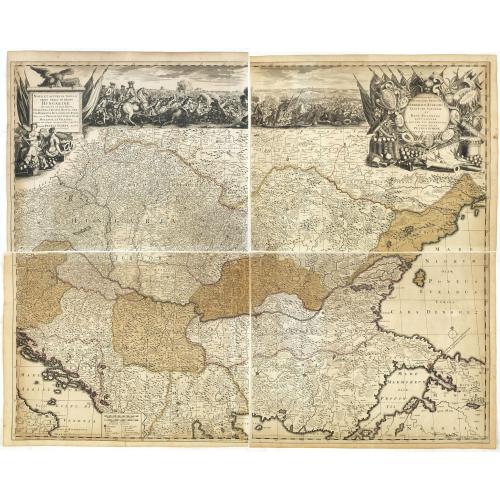Subscribe to be notified if similar examples become available.
Nova et accurata Tabula sedis belli in Regno Hungariae. Accendunt cetera Regna Sclavonia, Croatia, Bosnia, Servia, Dalmatia, Bulgaria et Romania . . . |
||||||||||||||||||||
|
||||||||||||||||||||
|
|
||||||||||||||||||||
|
Selling price: $1750
Sold in 2016 Missed this item! Be the first to get notified about our newly added listings. Add your name to our mailing list. |
||||||||||||||||||||
Description
A large battle scene showing the battle of Vienna (1683) in top. The battle was fought by the Habsburg Monarchy, the Polish-Lithuanian Commonwealth and the Holy Roman Empire, under the command of King John III Sobieski against the invading Muslim Ottoman Empire and its vassal and tributary states, and took place at Kahlenberg Mountain near Vienna.
The battle marked the first time Poland and the Holy Roman Empire had cooperated militarily against the Turks, and it is often seen as a turning point in history, after which "the Ottoman Turks ceased to be a menace to the Christian world".
In the upper right corner a dedicational cartouche with coats of arms of Croatia, Bosnia, Transylvania, Hungaria, Servia, Slavonia and Matia.
Dedication to Frederick Augustus I, who was Elector of Saxony and designated King of Poland. He was the second (but eldest surviving) son of Frederick Christian, Elector of Saxony, and Maria Antonia Walpurgis of Bavaria, Princess of Bavaria. Because he was underage at the time of the death of his father in 1763, his mother served as Regent until 1768. His uncle Prince Franz Xavier functioned as his representative.
In 1765 Prince Franz Xavier ceded the Polish throne to Stanislaw II Augustus on behalf of the underage Elector. Frederick Augustus was named successor to Stanislaw, however, when a Polish Constitution was ratified by the lower House (Sejm) of the Polish Parliament.
At the same time, the head of the Saxon Royal House was established as heir to the Polish throne (Article VII of the Polish Constitution).
Frederick Augustus declined to accept the crown upon Stanislaw's death in 1798, because he feared becoming entangled in disputes with Austria, Prussia and Russia, who had begun to partition Poland in 1772.
As a matter of fact, a full partition of Poland among the neighboring powers of Austria, Prussia, and Russia had already taken place by 1795.
Reference: Atlas Hungaricus, Schenck 3.
FAQ - Guarantee - Shipping
Buying in the Buy-it-Now Gallery
This item is available for immediate purchase when a "Add to Cart" or "Inquire Now" button is shown.
Items are sold in the EU margin scheme
Payments are accepted in Euros or US Dollars.
FAQ
Please have a look for more information about buying in the Buy-It-Now gallery or about bidding at auction.
Many answers are likely to find in the general help section.
Like this item?
![]()
Thinking about buying later on?
Or create your virtual collection !
With Wishlist you can collect all Your Favorite maps in one place by simply pressing a button!
Add this item to
Wish List
See my WishList here. [ Read More ]
Authenticity Guarantee
 We provide professional descriptions, condition report and HiBCoR rating (based on 45 years experience in the map business)
We provide professional descriptions, condition report and HiBCoR rating (based on 45 years experience in the map business)
We fully guarantee the authenticity of items we sell. We provide a certificate of authenticity for each purchased item.
Shipping fee
A flat shipping fee of € $ 30 is added to each shipment within Europe and North America. This covers : International Priority shipping, Packing and Insurance (up to the invoice amount).
Shipments to Asia are $ 40 and rest of the world $50
We charge only one shipping fee when you have been successful on multiple items or when you want to combine gallery and auction purchases.
Read More about invoicing and shipping
| High-Resolution Digital Image Download | |
|
Paulus Swaen maintains an archive of most of our high-resolution rare maps, prints, posters and medieval manuscript scans. We make them freely available for download and study. Read more about free image download |
In accordance with the EU Consumer Rights Directive and habitually reside in the European Union you have the right to cancel the contract for the purchase of a lot, without giving any reason.
The cancellation period will expire 14 calendar days from the day after the date on which you or a third party (other than the carrier and indicated by you) acquires, physical possession of the lot. To exercise the right to cancel you must inform Paulus Swaen Europe bv, which is offering to sell the lot either as an agent for the seller or as the owner of the lot, of your decision to cancel this contract by a clear statement (e.g. a letter sent by post, or e-mail (amsterdam@swaen.com).
To meet the cancellation deadline, it is sufficient for you to send your communication concerning your exercise of the right to cancel before the cancellation period has expired.
